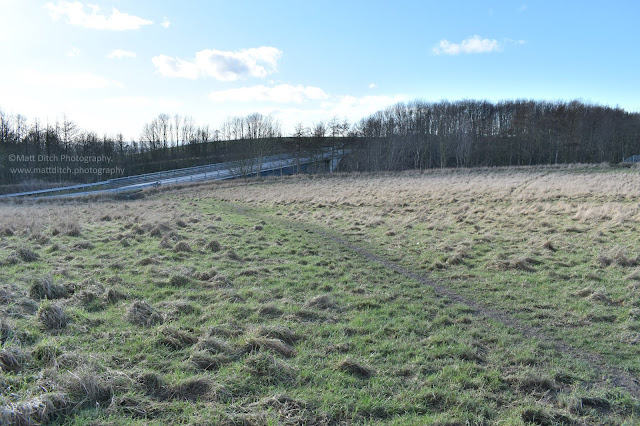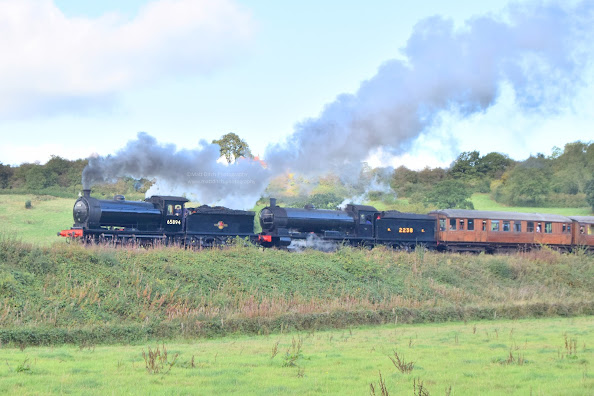The Lambton Waggonway
Lambton Works which was the headquarters of the railway. In the background is the remaining headgear of the former Dorothea Pit, but this time-serving only as an emergency shaft. © Copyright Alan Murray-Rust and licensed for reuse under this Creative Commons LicenceThe Lambton Waggonway or Newbottle Waggonway as it also appears to have been known was a waggonway that linked the coal fields of Durham with the River Wear at Lambton Staithes. It can trace its roots back to the early 1700s when a horse-drawn waggonway was constructed to link the mines around Fatfield with the River Wear at Cox Green. Sometime in the early 1800s a line was built between Burnmoor and Philadelphia. The latter became the engineering base of the Lambton system. Some of the orignal structures still stand to this day.
A recreated wooden waggonway at Beamish museum.
By 1819 the Newbottle waggonway had been acquired and integrated with the Philadelphia and Burnmoor section. A waggonway was built from Herrington Pit, East of Philadelphia, to Sunderland. At some point the route from Herrington towards Grindon was rebuilt on a different alignment. The old alignment appears to have run to the south of the current one through what is today the Barnes park extension. It joined with the newer alignment near the site of Grindon Library on Grindon Lane. The waggonway was worked via a series of stationary engines and was eventually closed around 1870 and all traffic was diverted via the Penshaw branch.
A lot of the course of the waggonway east from Grindon has been lost under housing and roads, but it is possible to follow the course from the eastern side of Foxcover bank over Hastings hill and then down Foxcover bank in the direction of Herrington park. The site of the Staithes on the River Wear is now the Riverside park and will feature in a future blog post.
Looking down the last traceable section of the waggonway. From here the route has been built on. But it would have run alongside what is today Chester Road. A bridge dating from 1855 which carried the waggonway over one of the access roads into Bishopwearmouth Cemetery survived into the 1960s. But, it was demolished when the entrance was remodelled. Remains of a stationary engine were also reported to have been found in the grounds of the nearby hospital.
Looking east from near the summit of Foxcover bank in the direction of the last photo. The trees towards the centre of the above image are the ones in the previous image. A short walk from the summit lies Hastings Hill where a Prehistoric burial site dating from around 2,000BC was discovered. Some of the items excavated have been put on display in Sunderland Museum.
The site of Foxcover engine in March 2021. The waggonway would have run right to left at this location. The A19 cuts through the course of the waggonway near here. To follow the waggonway from here you must cross the road bridge in the picture then follow the power station access road for a short distance. The route of the waggonway will appear on the right as it heads through what is today known locally as "the black woods".
The trackbed running through Foxcover plantation/black woods. This shot is looking back up Foxcover bank towards Foxcover engine. A junction existed near here where a short line ran to Cummings Quarry.
The quarry can still be seen to this day, but there is no trace of the line that served it. If you are heading down the incline in the direction of Herrington the quarry can be seen on the right.
A section of "Fish bellied" rail found just off the trackbed of the waggonway. This type of track was laid on square stones instead of long wooden sleepers. Many early railways were built using this type of track.
The approximate site of Herrington Engine and coal depot located at the foot of Foxcover bank. From here the course of the waggonway has been lost under Herrington park. But the course can be picked up again on the western edge near the miners memorial.
The miners memorial sits roughly on the site of Herrington pit which opened in 1874 and closed in 1985. The waggonway east from here closed in around 1870 but the section from here heading west remained open as part of the Lambton, Hetton & Joicey colliery railway and later National coal board. Trains from here travelled to Penshaw and then ran over the North Eastern Railways "Penshaw Branch".The next major point of interest on the route is the Lambton engine works at Philadelphia. Today a lot of the former buildings still stand. But, the area has been sold for redevelopment.
An old shed complete with its original shed doors. This can easily be seen from the footpath that now occupies the trackbed past the works site.
The locomotive erecting shop. This part of the works is private-land the picture was taken from the trackbed which passes alongside the works. Even after closure of the Lambton system in the mid 1980s the works remained open to repair locomotives from the other systems in the region. The last standard gauge locomotive to be worked on was Andrew Barclay diesel 615, which has survived into preservation and is currently based at the Aln Valley Railway near Alnwick.
Between the erecting shop and running sheds (pictured above) lay Newbottle Colliery/ Neasham main Colliery/ Dorothea pit. It was open from 1816 to 1956. Sadly the above sheds were demolished in around 2017. They did not only house industrial engines and for a time during the 1970s A4 Pacific "Sir Nigel Gresley" was based here. The following images were taken by Gordon Stubbs in April 1977. Please do not reuse these images.
From the works the course of the Waggonway crossed Philadelphia lane and headed in the direction of Margaret Pit and the junction with the Houghton branch. The Houghton branch served Houghton Colliery which operated between 1823 and 1981. The capped shafts can still be seen to this day.
"SNG" being hauled by a former British Rail shunter near Houghton Junction. The pair are heading in the direction of Junction bank where the "Junction Engine" was located. Since the closure of the Lambton system Junction bank has been removed and the area redeveloped as "Elba Park" a mix of housing and a park similar to Herrington. The park was once the site of Bourn Moor Colliery, D Pit and Lady Anne pit. But there also a number of other pits located in the area such as B pit.
In 1995 the remains of a wooden waggonway were discovered close to the site of Firebrick works, which was once part of the extensive colliery complex which occupied Elba park. The above sculpture shows what was discovered. The tracks have since been reburied to preserve them for future generations. Elba park was also the area where a number of lines branched off to serve other collieries and mines. There was the Lumley branch which served Lumley sixth pit, Lumley Colliery 2nd pit and 3rd pit. The Cocken branch also came off the Lumley branch and served, Eighth pit and George pit. It also had a connection with the Lumley waggonway.
Running south towards Fencehouses and Rainton was the lines that served Sherburn Collieries near Durham. But trains ceased running to these in 1914 when the collieries were sold. A section was kept open that linked with the Hetton section allowing trains to and from Hetton and Philadelphia.
I will be doing follow-up parts on the Penshaw branch and the line to Lambton Staithes along with the Hetton Colliery railway over Warden law in the near future.
If you’ve enjoyed this then please consider supporting this website so that I can continue to deliver new content like this. Patreon and Ko-Fi




















Comments
Post a Comment